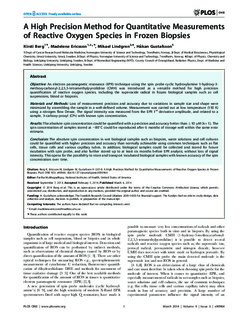| dc.contributor.author | Berg, Kirsti | |
| dc.contributor.author | Ericsson, Madelene | |
| dc.contributor.author | Lindgren, Mikael | |
| dc.contributor.author | Gustafsson, Håkan | |
| dc.date.accessioned | 2015-11-24T13:07:36Z | |
| dc.date.accessioned | 2015-12-04T11:40:51Z | |
| dc.date.available | 2015-11-24T13:07:36Z | |
| dc.date.available | 2015-12-04T11:40:51Z | |
| dc.date.issued | 2014 | |
| dc.identifier.citation | PLoS ONE 2014, 9(3):e90964 | nb_NO |
| dc.identifier.issn | 1932-6203 | |
| dc.identifier.uri | http://hdl.handle.net/11250/2366972 | |
| dc.description.abstract | Objective:
An electron paramagnetic resonance (EPR) technique using the spin probe cyclic hydroxylamine 1-hydroxy-3-methoxycarbonyl-2,2,5,5-tetramethylpyrrolidine (CMH) was introduced as a versatile method for high precision quantification of reactive oxygen species, including the superoxide radical in frozen biological samples such as cell suspensions, blood or biopsies.
Materials and Methods:
Loss of measurement precision and accuracy due to variations in sample size and shape were minimized by assembling the sample in a well-defined volume. Measurement was carried out at low temperature (150 K) using a nitrogen flow Dewar. The signal intensity was measured from the EPR 1st derivative amplitude, and related to a sample, 3-carboxy-proxyl (CP•) with known spin concentration.
Results:
The absolute spin concentration could be quantified with a precision and accuracy better than ±10 µM (k = 1). The spin concentration of samples stored at −80°C could be reproduced after 6 months of storage well within the same error estimate.
Conclusion:
The absolute spin concentration in wet biological samples such as biopsies, water solutions and cell cultures could be quantified with higher precision and accuracy than normally achievable using common techniques such as flat cells, tissue cells and various capillary tubes. In addition; biological samples could be collected and stored for future incubation with spin probe, and also further stored up to at least six months before EPR analysis, without loss of signal intensity. This opens for the possibility to store and transport incubated biological samples with known accuracy of the spin concentration over time. | nb_NO |
| dc.language.iso | eng | nb_NO |
| dc.publisher | Public Library of Science | nb_NO |
| dc.title | A high precision method for quantitative measurements of reactive oxygen species in frozen biopsies | nb_NO |
| dc.type | Journal article | nb_NO |
| dc.type | Peer reviewed | en_GB |
| dc.date.updated | 2015-11-24T13:07:36Z | |
| dc.source.volume | 9 | nb_NO |
| dc.source.journal | PLoS ONE | nb_NO |
| dc.source.issue | 3 | nb_NO |
| dc.identifier.doi | 10.1371/journal.pone.0090964 | |
| dc.identifier.cristin | 1128052 | |
| dc.description.localcode | © 2014 Berg et al. This is an open-access article distributed under the terms of the Creative Commons Attribution License, which permits unrestricted use, distribution, and reproduction in any medium, provided the original author and source are credited. | nb_NO |
